| Alan Garrow Didache |
the problem page
"When I first encountered the Synoptic Problem, the leading Two-Document Hypothesis appeared to rest on two highly improbable contentions, (1) that a document of faith as ostensibly influential as Q had simply evaporated without a trace from the historical record, and (2) that the later of Matthew or Luke had somehow remained unaware that another gospel of similar scope and content had already been published. To sustain such intuitively improbable premises one would need to demonstrate conclusively that both Matthew and Luke had no awareness of the other. In exploring the arguments favoring Q and the 2DH, it became apparent that the discussion was entirely focused on Luke’s unlikely use of Matthew, while there was a palpable silence on Matthew’s possible awareness of Luke. Moreover, every argument used to show that Luke did not know Matthew did not operate in reverse. Thus I began to suspect that the Q theory was a house built upon sand, and that Matthew’s use of Luke might be a viable solution to the Synoptic Problem."
0 Comments
"My attitude to the Synoptic Problem was influenced, during my undergraduate studies, by RT France. He was highly sceptical of Q and also generally steered clear of favouring any one hypothesis. By the time I finished my BA, therefore, I was definitely a Q skeptic - although one that generally leaned towards the Farrer Hypothesis. A major change occurred in 1998 during my doctoral studies (supervised by the 2DH advocate Christopher Tuckett). While working on the Didache's relationship to Matthew's Gospel I came across the curious triangular relationship between Did. 1.2-5a, Matt 5.38-48 and Luke 6.27-37: Didache 1.2-5a These Didache sayings are remarkable because there are very good reasons for suspecting that Did. 1.3-5a was added to a version of the text that already included Did. 1.2. This is important because, in Luke 6.27-36, elements similar to both Did. 1.2 and 1.3-5a are combined into a seamless, unified whole. This caused me to suspect that Luke's set of sayings had been woven out of the cloth provided by the whole of Didache 1.2-5a (rather than the reverse as was more commonly assumed). Furthermore, I then noticed a very peculiar pattern of similarity and difference between all the three versions: wherever Matthew's version is dissimilar to Luke's, his version is similar to the Didache's. The only reasonable way to explain this, it seemed to me, was to allow that that Matthew had attempted to conflate Luke's version with the sayings in the Didache. (A fuller presentation of this proposal is offered here).
Contemplating this possibility reminded me of a comment made by Michael Goulder in, 'Is Q a Juggernaut' (JBL, 1996): '[I]n a scientific subject a paradigm shift is possible because new and irrefutable evidence may come to light, new evidence in arts subjects is rare, and so are paradigm shifts' (p. 669). Here, it seemed to me, was a tiny piece of new evidence. It was tiny, but it was enough to shake me out of my prior assumptions. Why could not Matthew have used Luke? And why, if Matthew used Luke, could they also not have had access to sources they both shared (in addition to Mark)? Once I started to look at the Synoptic relationships with these questions in mind I came increasingly to suspect that Matthew was an author who had sought to harmonise and conflate together a range of earlier traditions, including Mark, Luke, portions of the Didache, and probably several other written and oral sources. This line of approach, it seemed to me, preserved all the strengths of the Farrer and Two Document Hypotheses without reproducing their weaknesses. Sometimes friends suggest that my arguments for Matthew's use of Luke would be more appealing if I kept it simpler - i.e. stopped including Did. 1.2-5a. I understand what they mean, which is why I tried to keep the Didache to one side in my initial presentation of the Matthew Conflator Hypothesis. For me, however, Did. 1.2-5a is the jewel of great price that has lain abandoned in a field since its discovery in 1873. New historical evidence of this quality, as Michael Goulder rightly observed, hardly ever comes to light. It seems a shame, therefore, to refuse to allow it to shake our old assumptions. But, of course, such a suggestion is stupidly naive. If we allowed our old assumptions to be disturbed, we would face the massive upheaval of having to wrestle with something disturbingly new."
Erik answered my question as follows:
"I have read my NTS-article from 2001 again and now I remember. What put me on the track was the astonishing correspondence between Lk 4:25–27 about the widow in Zarephath in Sidon with a sick child and the pagan officer Naaman on the one hand and on the other hand Mt 8:5–13 about the pagan officer and Mt 15:21–28 about the woman in the district of Tyre and Sidon with a sick child. Only Matthew has both these stories and the Mt-redaction has assimilated them to each other, especially through putting in the "great faith" at the end, in 15:28 (not in Mark 7:24–30 – but in Mt 8:10), making these two pagans, one man and one woman, the only two persons whom Jesus praises for their great faith. Matthew obviously wants the stories to be seen as a pair that belongs together, as the two OT counterparts do in Luke 4:25–27. The Mt-redaction also put in "Sidon" at the beginning, in Mt 15:21, not mentioned in Mk 7:24, but in Lk 4:26 – a sign that Mt also wants us to see the connection between the two NT-pagans and their OT counterparts mentioned in Lk 4:25–27. That was and is enough to convince me that Matthew knew the saying Luke 4:25–27. My reasons are elaborated in paragraphs II-IV (pp. 431-436). And my explanation of the fact that Matthew does not render the saying himself, although it seems to be so important to him, is presented in paragraph VI (p. 439f). In short: he did not want to contradict the program as it is expressed in Mt 10:5f (and 15:24): first to Israel. But he also wanted to show how the incalculable reality, i.e. the surprising great faith of two pagans overcame the program. If this were the only evidence it might, however, also be explained through the assumption that Matthew just knew (the tradition behind) the saying recorded in Luke 4:25–27, not necessarily the whole Gospel of Luke. The tradition could be Syrian, as both examples are connected to Syria – and Mt is often presumed to emanate from Syria (p. 438). But I was more impressed and convinced especially by von Dobschuetz, Hengel and Huggins, and the last years even more by Garrow, that Mt in fact knew the whole of Luke (as well as the Q-tradition[s], p. 439 n. 41)." Attached is a Matthew's use of Luke bibliography. The quality of these contributions is, as might be expected, variable ...
"During my PhD program at Dallas Seminary in the 2000s, I took a course on the Synoptic Problem taught by Harold Hoehner. Dr. Hoehner was a proponent of the Two Gospel Hypothesis and had been a personal friend of William Farmer, who had also taught in Dallas, at Perkins School of Theology in Southern Methodist University. I began Hoehner’s course favoring the Two Document Hypothesis, but the required readings showed me that there were reasons to question Q. I then started to wonder why it seemed that everyone who disbelieved in Q concluded that Luke must have used Matthew as a source. Why not the reverse? Then I came across the article by Ronald V. Huggins, “Matthean Posteriority: A Preliminary Proposal” (NovT 34 [1992], 1-22). I found it intriguing and persuasive." Rob went on to publish his PhD dissertation as: Robert K. MacEwen, Matthean Posteriority: An Exploration of Matthew’s Use of Mark and Luke as a Solution to the Synoptic Problem, LNTS 501; London: Bloomsbury T&T Clark, 2015. Here is the final paragraph of an RBL review by J Andrew Doole: In New Testament gospel studies, of course, the 2DH remains the democratically elected head of state. The leader of the opposition has recently been a post held securely by the FH, and it is refreshing to have a new case for a peripheral candidate. MacEwen almost always comes down against the 2GH, whose position becomes all the more untenable. His criticism of his main rival, the FH, proves successful in many regards and should be taken seriously by anyone considering Lukan familiarity with the Gospel of Matthew. At times one wonders if the arguments against the established 2DH are directed too specifically to the International Q Project and the idea of a reconstruction of Q. Nevertheless, MacEwen is surely correct in concluding, following a desideratum of an MPH commentary on the Gospel of Matthew, that the theory of Matthew’s familiarity with Luke “is worthy of more consideration than scholars have usually given it” (196). He has certainly convinced me. For most of my career I thought the Q hypothesis was the most convincing explanation of the material common to Matthew and Luke, though with the proviso that maybe Q was not a single source. When comparing parallel passages in these two Gospels in detail, I usually found that redactional changes to a common source by the respective evangelists explained satisfactorily their similarities and differences. What changed my mind about Q was the problem of envisaging what the source as a whole could have been like. Q is often said to have been a sayings collection, but in fact the Q material begins with a substantial amount of narrative and then seems to abandon narrative form in favour of sayings alone, sometimes with a brief narrative setting but often not. As a piece of literature, this is incoherent. I doubt if this problem can be solved by dividing Q into more than one source, though I would be open to a sustained argument along those lines if anyone were to develop one.
But the impression one gets from virtually all studies of the Synoptic problem is that the only viable alternative to Q is the Farrer hypothesis (Luke’s use of Matthew). I have never found that hypothesis credible. The major problem I see is the way that Luke would have had to rearrange the material he shares with Matthew. The common objection along these lines has been: Whywould Luke break up Matthew’s well structured and coherent discourses and scatter the material around his Gospel? Advocates of the Farrer hypothesis have devoted their defences to answering that question. But my problem is with the how, not the why. The process by which Luke would have had to select and arrange the material he takes from Matthew (which would have involved very carefully avoiding any Markan material in the context of this Matthean material) would have been extremely complex. Alan Garrow has shown this very convincingly, and it can only be appreciated by people who are willing to sit down with a synopsis and examine the parallel texts in detail. Francis Watson in his book Gospel Writing has now made the best available attempt to explain and account for Luke’s compositional procedure. I doubt if anyone could do better, but I ended reading it with the conclusion: This is unbelievably complex. It is also completely unparalleled in the way that other ancient authors worked with their sources. So I hung onto Q for longer than I would otherwise have done because I still found it more credible than Luke’s use of Matthew. But occasionally the question occurred to me: why has hardly anyone even attempted to explore the possibility that Matthew used Luke? It seemed like a solution that had never been tried, rather than one that been tried and found wanting (as one might say of the Griesbach hypothesis). I discovered that it had been proposed (by Christian Gottlob Wilke), back in the nineteenth century just when the Q hypothesis originated and became popular. At that stage most scholars adopted the latter, and the “Wilke hypothesis” (as we might have called it had anyone pursued it then) was forgotten. When eventually an alternative to Q again appeared on the scholarly horizon, it was the Farrer hypothesis. To me Matthew’s use of Luke had the obvious advantage of avoiding what I found incredible in the Farrer hypothesis. Though Matthew’s compositional procedures, if he took the “Q” material from Luke, would involve often conflating Luke with Mark (in the way that advocates of Q envisage him conflating Q with Mark), his procedures would be much less complex and difficult than those of Luke according to the Farrer hypothesis. A further consideration is that Q scholars, when judging whether Matthew or Luke preserved the more “primitive” form of a saying of Jesus, tend in a large majority of cases to decide for Luke. While the criteria for making these judgments are often not very secure, the overall impression that Luke has the earlier form of sayings he shares with Matthew should surely make it worth considering the hypothesis that Matthew took the “double tradition” material from Luke, rather than vice versa. (Since B. H. Streeter, the case for Q has standardly included the “alternating primitivity” of the “double tradition” material. In other words, sometimes Matthew, sometimes Luke preserves the more primitive form. This assertion seems to have obscured the fact that actually most scholars working with the Q hypothesis judge Luke to be more primitive far more often than they judge Matthew to be.) These considerations mean that, if one begins from the position of thinking that the Q hypothesis works rather well in many respects, as I do, but find it in the end unsatisfactory, as I do, then the more obvious of the other two principal possibilities must be Matthew’s use of Luke, not Luke’s use of Matthew. Many of the really good arguments for Q can also support Matthew’s use of Luke. Encouraged by the work of Robert MacEwen and Alan Garrow, who have devoted far more time and effort to exploring the “Matthean Posteriority” hypothesis (as MacEwen calls it) than I can spare, I decided I had sufficient reason to adopt it as a working hypothesis. The reason I am 99% convinced of Markan priority is that I have worked with it as a plausible hypothesis throughout my career and have always found it made good sense of the data. I have now made a start to working with Matthew’s use of Luke as a working hypothesis and so far it seems to me to doing well. The main reason the Synoptic Problem is difficult is that it involves working on both macro- and micro-levels. In other words, a hypothesis must give a plausible account of what an evangelist is doing with his sources overall and why he should be doing it, but it must also meet the test of explaining the precise similarities and differences between the parallel texts of each Gospel in each pericope. Probably this is a reason why so few people have so far taken “the road less travelled” – Matthew’s use of Luke. At SBL Denver 2018, Mark Goodacre will set out what he sees as the weakest points in the case for Matthew's use of Luke. If I were present I would like to ask him what he sees as the weakest point in the case for Luke's use of Matthew (the Farrer Hypothesis). This type of question is often worth asking of seasoned specialists - because they are usually experts in where their favoured hypothesis is weakest as well as where it is strong. (I will ask the same question of a couple of supporters of Matthew's use of Luke later in this series).
I suspect most scholars would say that the biggest problem for the Farrer Hypothesis is that it requires Luke to treat Matthew in ways that are uniquely complicated (cf. upcoming posts in this series). Not only is Luke's supposed treatment of Matthew unlike that of any other ancient author, it is also generally unlike Luke's treatment of Mark. While evaluating Goodacre's objections to Matthew's use of Luke it might be worth asking: How do these objections compare with the biggest problem with the Farrer Hypothesis? Are they in the same league? ------------------------ Mark was kind enough to respond to my question via Facebook: "Thanks Alan. I don't think the Farrer Theory has any weak points. If it did, I wouldn't have advocated it and would instead have advocated for a different hypothesis that lacked weak points." This response is, however, problematic for two reasons: 1) There is good evidence to suggest that Goodacre did not give serious attention to the possibility that Matthew might have used Luke until after cementing his reputation as a leading advocate of the Farrer Hypothesis. This much is suggested by the remark in The Synoptic Problem: A Way Through the Maze (2001, p. 108): 'The theory that Matthew has read Luke ... is rarely put forward by sensible scholars and will not be considered here.' Commenting on this statement in more recent debate Goodacre has explained that he was merely reflecting the state of research at the time. It seems reasonable to suspect, therefore, that this statement also reflects the state of his own research at the time. 2) In his first book on the subject, Goulder and the Gospels (1996), Goodacre notes weaknesses, as well as strengths, in the Farrer Hypothesis. 2018 year saw the publication of Gospel Interpretation and the Q-Hypothesis edited by Mogens Müller and Heike Omerzu (LNTS, Bloomsbury). This represents selected output from a conference held in Roskilde, Denmark in 2015 - at which a high proportion of the best, currently active, Synoptic Problem specialist were present. The volume is striking in two respects. First, every contributor is confident that Mark is the first of the three Synoptic Gospels. Second, it is remarkable how often contributors state something along the lines of: 'the Synoptic Problem is not yet solved'. This state of affairs is worth reflecting upon. If we are confident that Mark was first, then this leaves three possible (simple) solutions: 1) Matthew used Luke 2) Luke used Matthew 3) Matthew and Luke independently used Q If, after decades of sustained enquiry, we continue to suspect that options 2) and 3) don't fully solve the Problem, then it follows that option 1) might, after all, be correct. So, if you are very confident that Mark is the first Gospel, while also suspecting that the Synoptic Problem has not yet been solved (by the mainstream hypotheses), then may I encourage you to consider option 1): Matthew used Luke?
This year's annual meeting of the SBL/AAR sees an important development in the study of the Synoptic Problem: for the first time in a long time at SBL a 'new' solution to the Problem will come under the scrutiny of a major specialist scholar. Prof Mark Goodacre will present a paper: 'Why not Matthew's use of Luke?' (see abstract below). To mark this occasion I've created a series of twenty-four blog posts - one for every day in the run-up to the session. If you plan to attend SBL I hope that this series, which will include contributions by Evan Powell (creator of the $1,000 Challenge), Rob MacEwen, Erik Aurelius and Richard Bauckham, will whet your appetite for what should be a lively session. If, like me, you are unable to attend this year's SBL, then I hope these posts will provide a means of keeping in touch with this potentially important debate. Why Not Matthew's Use of Luke? |
AuthorAlan Garrow is Vicar of St Peter's Harrogate and a member of SCIBS at the University of Sheffield. Archives
April 2024
Categories |
||||||||||||
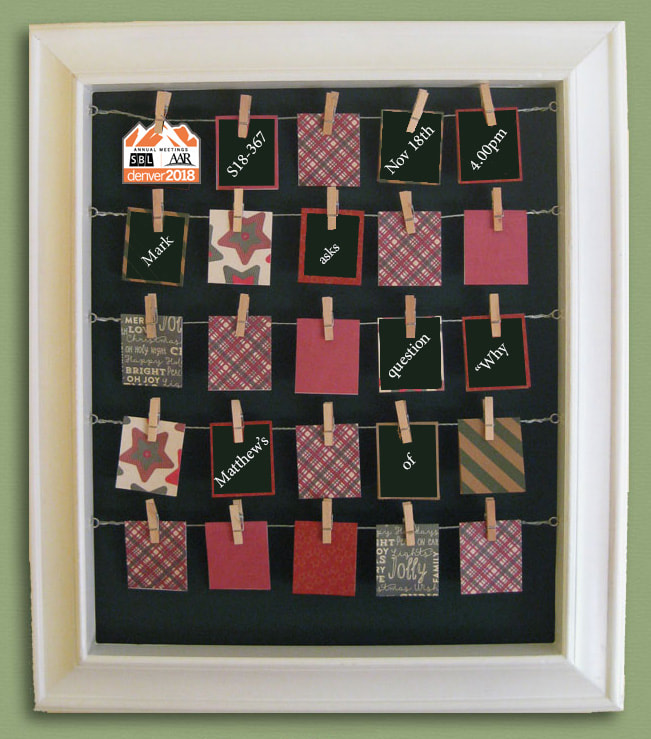
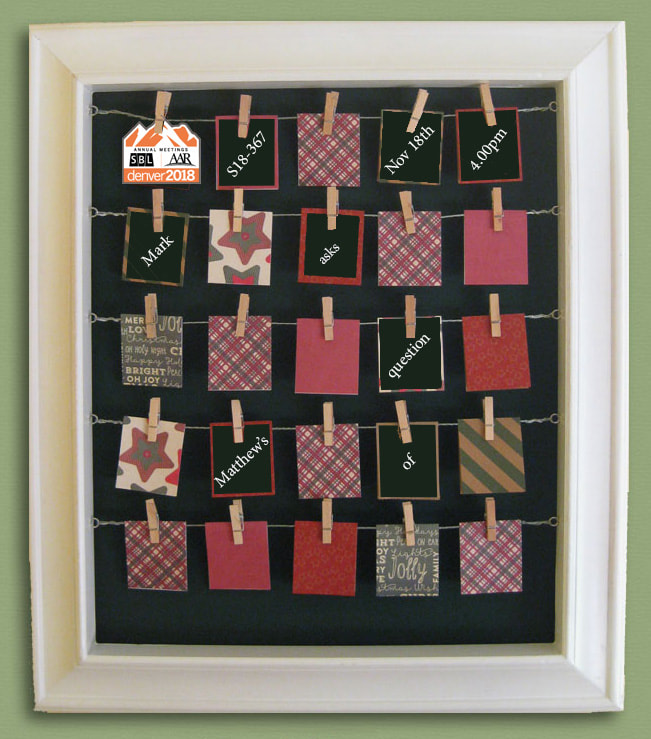
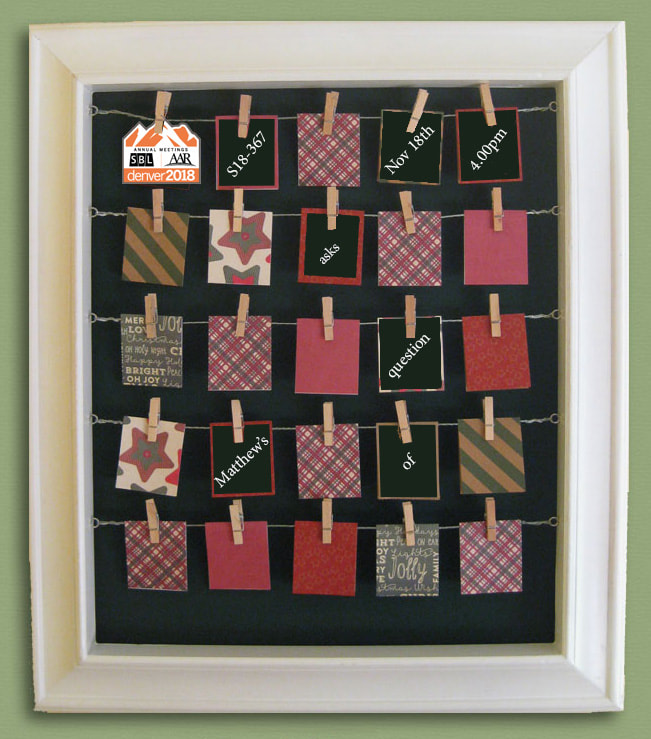
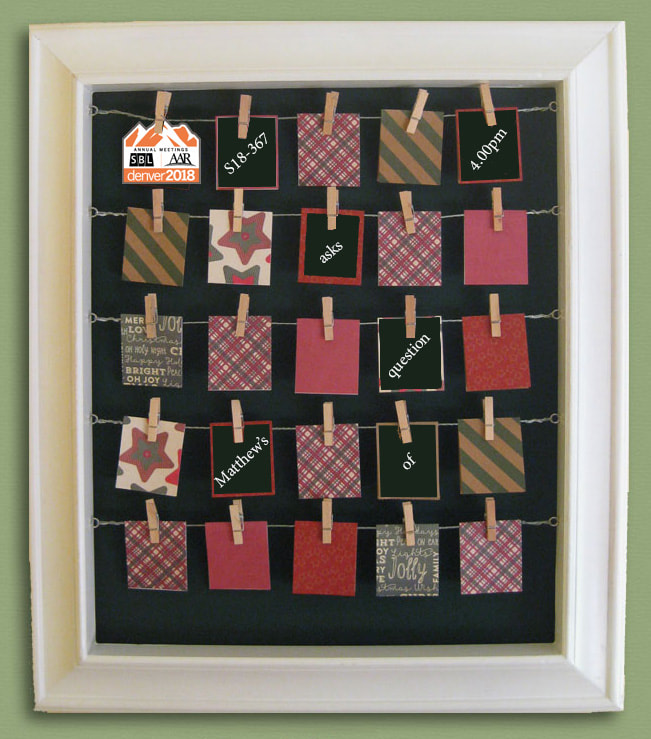
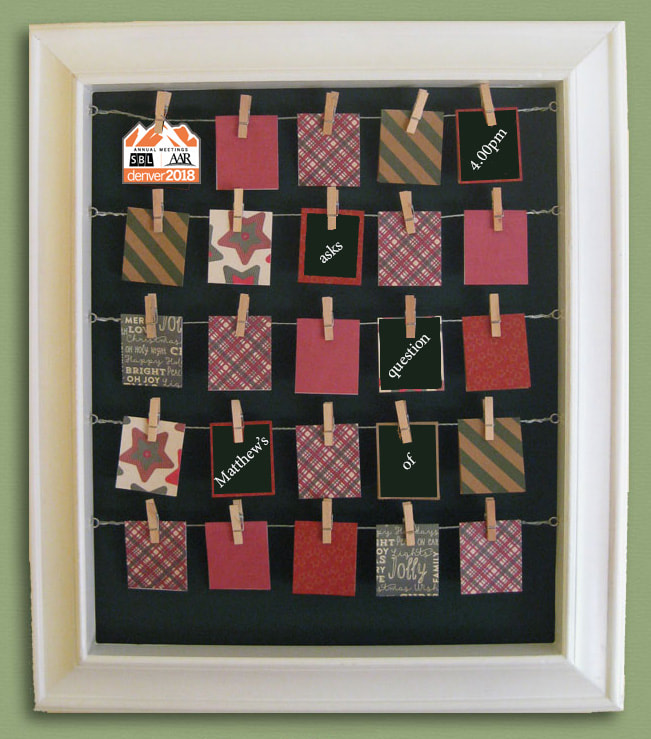
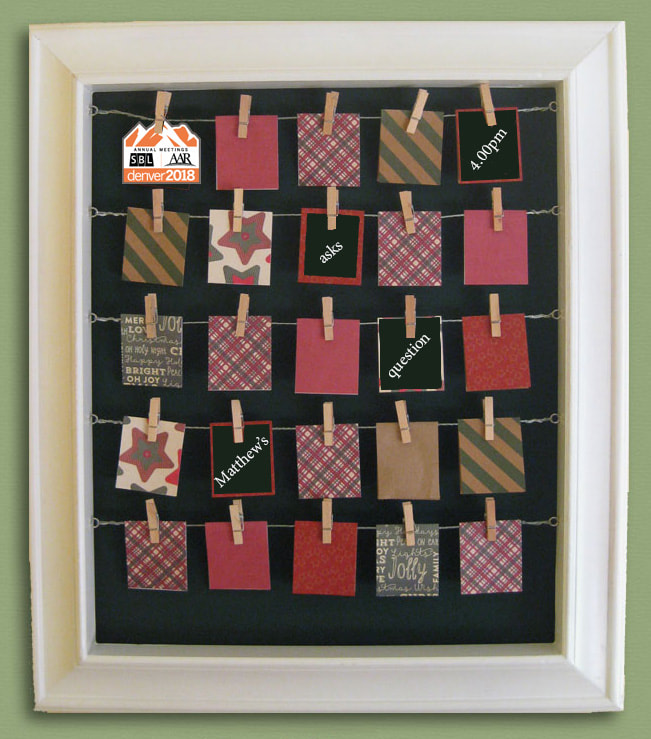
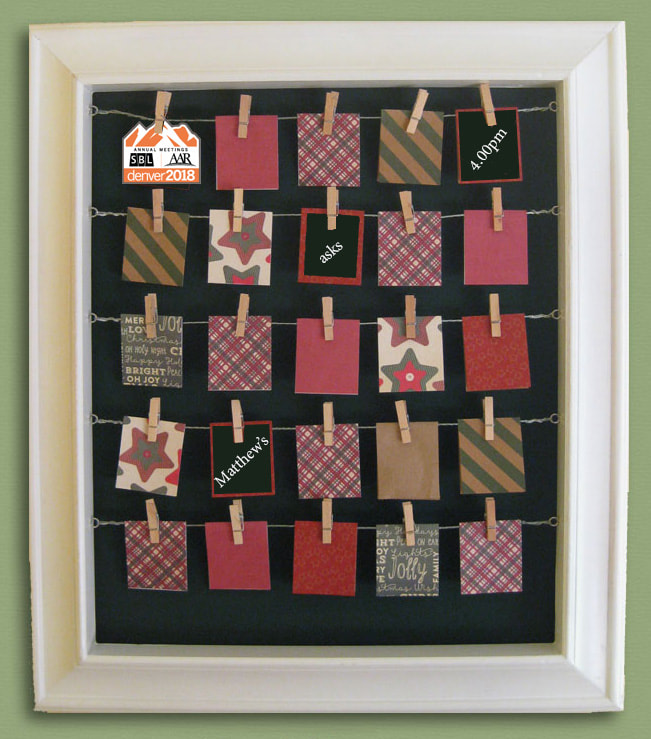
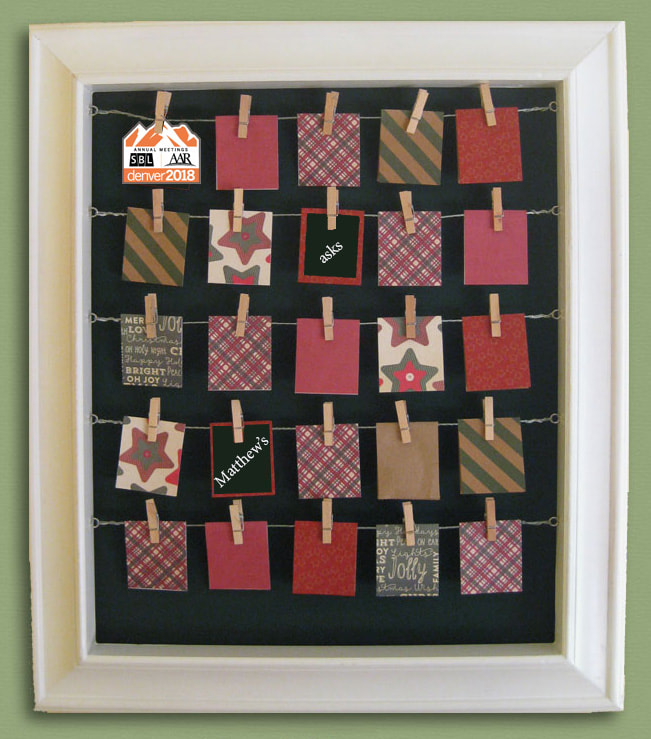
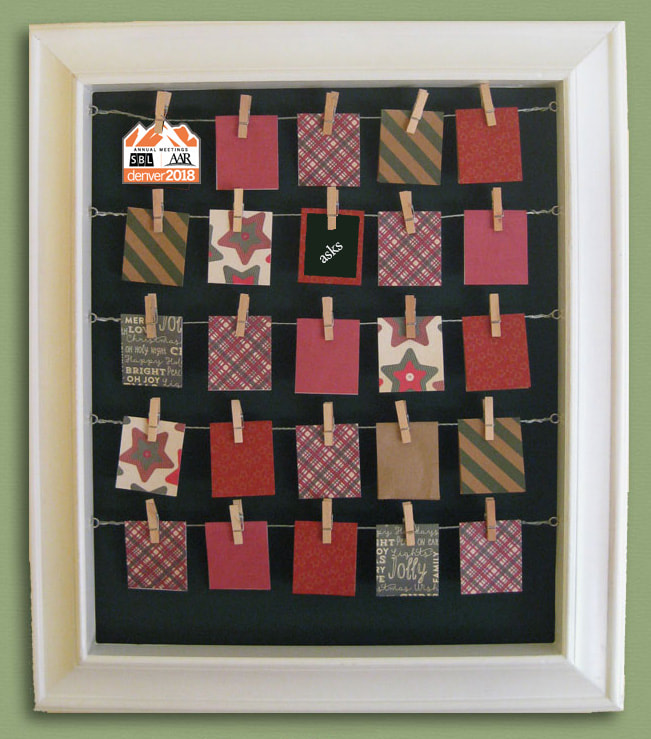
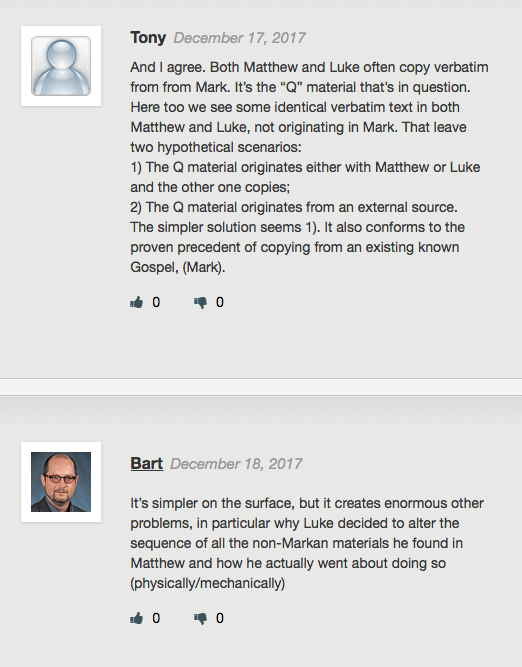

 RSS Feed
RSS Feed